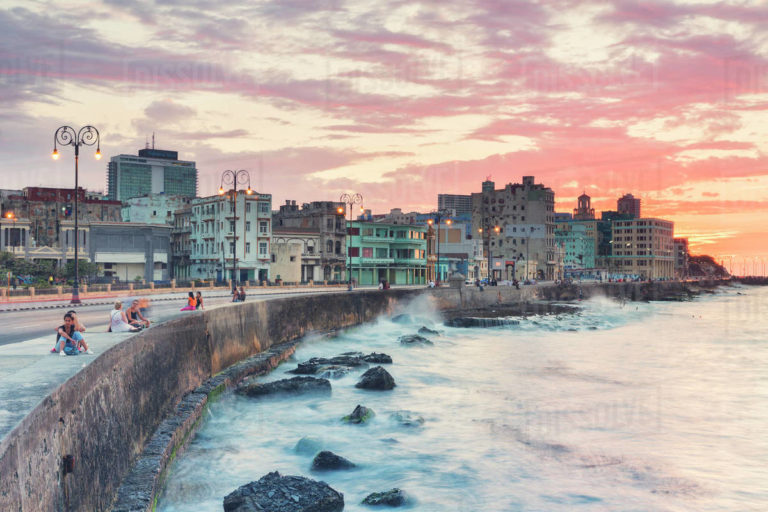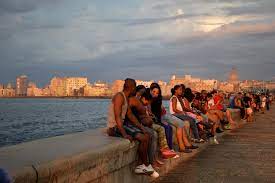
EL MALECON DE LA HABANA, CUBA, “EL SOFA MAS LARGO DEL MUNDO”. PHOTOS.
LA HABANA- A todos los extranjeros que visitan Cuba, la Habana Vieja puede ser el corazón y el alma de la ciudad, pero para los cubanos, es El Malecón. Técnicamente hablando, El Malecón es un bulevar de 5 millas de largo que se extiende a lo largo del agua, con la Bahía de La Habana a un lado y los límites de La Habana Vieja, el Vedado y Centro Habana al otro, dependiendo de dónde se encuentre. Pero metafóricamente hablando, El Malecón es a la vez un punto de encuentro y un lugar de refugio para los lugareños que buscan respirar aire fresco después de un largo día o noche.
El Malecón de La Habana, primero llamado Avenida del Golfo, es la avenida costera más famosa de Cuba, desde la desembocadura del Puerto de La Habana en La Habana Vieja, a lo largo del lado norte del barrio Centro Habana y el barrio Vedado, terminando en la desembocadura del rio Almendares.
HISTORIA DEL VIEJO MALECÓN DE CUBA
El proyecto fue realizado por Don Francisco de Albear, el mayor ingeniero cubano de la época. A Albear se le ocurrió un diseño complejo pero inteligente para el malecón, que iba a ser mucho más que un simple paseo marítimo. Según los registros históricos, la avenida debía construirse a 4 metros sobre el nivel del mar. Todo el proyecto costaría 850.000 pesos, pero el gobierno español no se atrevió a expedir el permiso de construcción y la propuesta de Albear fue pospuesta.
Pero la construcción del Malecón comenzó en 1901, durante el gobierno militar temporal de Estados Unidos. El objetivo principal de la construcción del Malecón fue proteger La Habana del mar y de los llamados Nortes americanos.
Para celebrar la construcción del primer tramo de 500 metros del Malecón, el gobierno estadounidense construyó una rotonda en el cruce del Paseo del Prado, que, según arquitectos de la época, fue la primera construida en Cuba con hormigón armado. Frente a la rotonda, donde todos los domingos bandas interpretaban melodías cubanas, se construyó el Hotel Miramar, muy de moda durante los primeros 15 años de la independencia, y que fue el primero donde los camareros vestían esmoquin (esmoquin) y chalecos (chalecos) con botones dorados.
Los gobiernos cubanos posteriores continuaron la ampliación del primer tramo del Malecón. En 1923 llegó a la desembocadura del río Almendares entre las calles K y L del Vedado, donde se construyó la Embajada de Estados Unidos, cerca del Parque Deportivo José Martí y, más lejos, el Hotel Rosita de Hornedo (hoy Sierra Maestra). .
En 1957 y 1958, la calzada sirvió como sede del Gran Premio de Cuba.
ETAPAS DE TERMINACIÓN
Desde su inicio en 1901 y 1902, desde el Paseo del Prado hasta la calle Crespo.
Entre 1902 y 1921 hasta el Monumento a las Víctimas del USS Maine.
Entre 1948 y 1952 hasta la desembocadura del río Almendares.
EL MALECÓN HOY
El Malecón sigue siendo popular entre los cubanos.
También es una fuente de ingresos para las familias más pobres, ya que los pescadores individuales arrojan allí sus señuelos. Además, es un punto crítico para la prostitución en Cuba por parte de hombres y mujeres.
Aunque las casas que bordean el Malecón están en su mayoría en ruinas, el Malecón sigue siendo uno de los destinos más espectaculares y populares de La Habana.
Pero más allá de los valores arquitectónicos de los edificios, su mayor encanto reside en ser un lugar para pasear o pasar el rato en un día de calor sofocante. Es un lugar al que acuden las parejas para hacer las paces, especialmente al atardecer, en compañía de niños y pescadores. Es el salón al aire libre de La Habana.
Durante el día es probable que veas a algunos residentes junto con algún turista, pero por la noche, especialmente al atardecer, es cuando verás bandadas de cubanos abrazando a sus seres queridos mientras contemplan el atardecer, multitudes de jóvenes riendo y bebiendo, pescadores esperando una captura o incluso una pequeña fiesta de baile. Y a veces es posible que no veas a nadie. En días particularmente tormentosos, las olas rompen contra El Malecón y gran parte del mar se derrama sobre las carreteras, lo que lo convierte en una excelente oportunidad para tomar fotografías.

THE MALECON IN HAVANA, CUBA, “THE LONGEST SOFA IN THE WORLD”. PHOTOS.
LA HABANA- For the foreign people visiting Cuba, Old Havana may be the city’s heart and soul, but to Cubans, it’s El Malecón. Technically speaking, El Malecón is a 5-mile-long boulevard that stretches along the water, with Havana Bay on one side and the edges of Old Havana, Vedado and Central Havana on the other, depending on where you are. But metaphorically speaking, El Malecón is both a meeting point and place of refuge for locals looking to catch a breath of fresh air after a long day or night.
The Havana Malecón, first named Avenida del Golfo, is Cuba’s most famous sea-side avenue,from the mouth of Havana Harbor in Old Havana, along the north side of the Centro Habana neighborhood and the Vedado neighborhood, ending at the mouth of the Almendares River.
HISTORY OF CUBA’S OLD MALECON
The project was undertaken by Don Francisco de Albear, Cuba’s greatest engineer at the time. Albear came up with a complex but smart design for the seawall, which was to be a lot more than just a promenade. According to historical records, the avenue was supposed to be constructed 4 meters above sea level. The whole project would cost 850,000 pesos, but the Spanish government didn’t bring itself to issue the construction permit and Albear’s proposal was postponed.
But the construction of the Malecón began in 1901, during temporary U.S. military rule. The main purpose of building the Malecón was to protect Havana from the sea and the so-called American Nortes.
To celebrate the construction of the first 500m section of the Malecón, the American government built a roundabout at the intersection of Paseo del Prado, which, according to architects of the period, was the first one built in Cuba with steel-reinforced concrete. In front of the roundabout, where every Sunday bands played Cuban melodies, the Miramar Hotel was built, which was very much in fashion for the first 15 years of independence, and which was the first one where the waiters wore tuxedos (dinner jackets) and vests (waistcoats) with gold buttons.
Subsequent Cuban governments continued the extension of the first section of the Malecón. In 1923, it reached the mouth of the Almendares River between K and L streets in Vedado, where the United States Embassy was built, near the José Martí Sports Park and, further out, the Hotel Rosita de Hornedo (today, the Sierra Maestra).
In 1957 and 1958, the roadway served as the venue of the Cuban Grand Prix.
STAGES OF COMPLETION
From the start in 1901 and 1902, from the Paseo del Prado to Calle Crespo.
Between 1902 and 1921 as far as the Monument to the Victims of the USS Maine.
Between 1948 and 1952 to the mouth of the Almendares River.
TODAY MALECON
The Malecón continues to be popular among Cubans.
It is also a means of income for poorer families as individual fishermen cast their lures there. In addition, it is a hotspot for prostitution in Cuba by men and women.
Although the houses lining the Malecón are mostly in ruins, the Malecón remains one of the most spectacular and popular destinations in Havana.
But beyond the architectural values of the buildings, its greatest charm lies in being somewhere to stroll or hang out on a stiflingly hot day. It is a place where couples come to make amends, especially at sunset, in the company of children and fishermen. It is Havana’s outdoor lounge.
During the day, you’re likely to see some residents along with a tourist or two, but at night, especially come sundown, is when you’ll see flocks of Cubans holding loved ones close as they watch the sunset, crowds of young people laughing and drinking, fishermen waiting for a catch or even a small dance party. And sometimes, you may not see anybody at all. On particularly stormy days, waves crash up against El Malecón and much of the sea spills onto the roads, making for a great photo op.

Agencies/ Wiki/ ElMaleconHist./ Extractos/ Excerpts/ Internet Photos/ Arnoldo Varona.
TheCubanHistory.com
THE CUBAN HISTORY, HOLLYWOOD.



